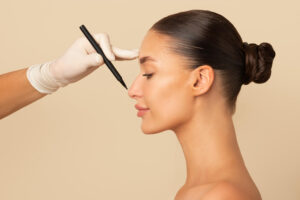A New Face: What Are the Psychological Risks?
Few topics are as polarizing as the escalating use of plastic surgery to alter the appearance of men, women and an increasing number of young adults. There are those who vehemently oppose the whole idea, seeing it as a sad reflection of our beauty- and youth-obsessed culture, while others embrace it as an opportunity to prolong the health and vitality of one’s appearance.
In spite of this ongoing debate, plastic surgery experts predict wider use by a broader spectrum of people as safer, more refined and affordable techniques are developed. According to the most recent report by the American Society for Aesthetic Plastic Surgery, close to 13 million cosmetic procedures were performed this year in the U.S. alone, representing a 155-percent increase over the past decade. With these numbers, our ongoing fascination with reality TV makeovers and the popularization of cosmetic procedures, it seems clear that plastic surgery is here to stay. And if so, it is important to consider not just the physical, but psychological consequences of this growing phenomenon.
As a psychologist who studies beauty and self-image, I am sometimes asked what my take is on it all? I respond — as psychotherapists often do — with a question. “Do you want to hear my short or long answer?” You see, there are two important but separate issues at hand: the immediate emotional concerns faced by patients opting to surgically alter their physical appearance, and the farther-ranging cultural one about what this trend means in terms of our definition of beauty, its impact on our self-image and on our society at large.
I am starting a two-part series on The Huffington Post to respond to these issues; the first one describing the psychological assessment that should be done — by doctor and patient — before considering going under the knife.
Initial Consultation
I approach patients who seek physical change through surgery like any other patient in psychotherapy who desires change. First, I try to put them at ease by letting them know that therapy is about exploring — not judging — and that I assume if they are considering surgery that they probably believe they have good reason for it. I respect their desire to look and feel better, but I tell them that I want to know more about that desire. Cosmetic changes may seem superficial, but they are permanent, can have far-reaching emotional consequences and deserve careful examination. To accomplish that, I suggest we suspend the question of whether it is right or wrong and focus instead on why it interests them. My goal is to help them know if it will meet their goals — inside and out.
Gathering Information
I take an in-depth psychiatric and psychosocial history. The purpose is twofold. I want to know if this procedure is safe for them physically as well as emotionally. For example, a patient requesting surgery with a history of serious depression, mania, anxiety or impulsiveness has a different prognosis than someone who has no history of serious mental illness. I ask if they are on any psychotropic medications or if they have a history of an eating disorder, alcohol or drug abuse. It is particularly important to know if a patient has had, or currently has, a thought disorder or delusional thinking, symptoms that are clear contraindications for cosmetic surgery.
Another problematic diagnosis is Body Dysmorhic Disorder (BDD), which can sometimes be camouflaged among surgery candidates. BBD is an excessive preoccupation with a physical defect that may be exaggerated or even imagined in a patient’s mind. Surgery on people with BDD or other serious mental illnesses can exacerbate their symptoms, setting off an increase in depression, mania and/or lead to adjustment problems and self-destructive behavior. Requests for repeated procedures sometimes follow immediately, along with expressions of outrage toward the surgeon and staff and even legal action for failing to “cure” their defect.
What, Why And For Whom?
After taking a careful history, I join together with the patient to explore their motivation for surgery. I listen for the psychological issues that I know may interfere with feeling satisfied with the permanent alterations they will be making to their faces and bodies.
First I ask, “What are you hoping to change?” Is it a feature that preoccupies the patient but appears normal to most everyone else? I literally ask them to point to the specific area they want changed, since sometimes it’s not all that evident. Is it a feature that makes them stand out in some obvious way — like huge ears, a facial scar or a drooping eye? Is it something that causes them pain or physically gets in the way of everyday functioning — like excessively large breasts or an abdominal hernia? Are they thin, but want to be thinner? From where do they want the excessive fat removed and how much? There is a difference between removing extra folds of skin following extreme weight loss and seeking multiple surgeries to remove fat unnoticeable to anyone but the patient. Altering a nose that isn’t perfectly shaped is different from removing a very visible mole that interferes with shaving. Another important question to ask is if the patient wants a change in a specific area or one they hope will help them look like an entirely different person?
Then I ask “Why now?” Does the request for surgery relate to the patient’s age — turning 40, 50 or 60 — the most common reason for plastic surgery today? Does it coincide with the onset of menopausal symptoms? Or, for men, the loss of virility or erectile function? Does it follow a divorce? The death of a parent? A child? A job? We know that new wardrobes and home renovations are often stimulated by the desire for new beginnings, so it’s important to know if similar precipitating factors play a role in the desire for a new face or body. These don’t necessarily rule out cosmetic surgery, but it’s helpful to know the motivation behind it.
Next I want to know, “For whom is this procedure being done?” Are they doing it for themselves or because of pressures placed on them by others? Although initial response to this question almost always is “of course it’s for me,” upon further exploration I find it is often more complicated. Sometimes the request for surgery is motivated by the desire to maintain a relationship — “my husband likes women with large breasts” or “my girlfriend is much younger and I’m afraid she’ll lose interest if I begin to look old.” Occasionally a patient admits that their friend, mate or even their mother is the person who suggested that they get surgery. Some receive gifts from loved ones in the form of a consultation with a surgeon or a year’s worth of Botox injections. It’s helpful for patients to hear themselves say out loud what actually led to their decision because it sometimes makes them think twice not just about surgery, but about their relationships.
Determining Expectations
Probably the most important challenge is to explore patient expectations and correct them. Research has shown that more satisfying results are directly related to realistic expectations of the surgical process and outcome, and there are some simple questions that can highlight potential unrealistic ones.
1.How does the patient expect the surgery to change them? I look for underlying self-esteem issues, personality conflicts, career problems or marital difficulties that the patient hopes will be fixed by surgery.
2.Do they have a picture of a beauty icon in mind and hope to emerge resembling them? This is a no-brainer, a dangerous sign of unrealistic expectations. Whether they walk into surgery with a celeb’s image in hand or not, it’s important to explore their transformation fantasies.
3.Do they want to recapture a younger version of themselves rather than a healthier or revitalized one for their age? I tell them 30 is not the new 50. Looking great at 50 is the new 50.
4.Are they looking for an easy way out of actively caring for themselves — planning to use surgery to avoid working out, eating well, limiting their drinking or exposure to the sun?
5.Are they convinced that plastic surgery is a one-time thing and unaware of the wear and tear factor? I remind them that most non-invasive cosmetic procedures — like botox and fillers — require regular upkeep, and that one surgery often leads to wanting more. Getting eyelids done can highlight the need for neck surgery and so on, the slippery-slope factor that I’ve written about here before.
6.Is there an assumption that loved ones will react positively to the surgical changes? Sometimes mates, children and parents feel uneasy, sad or even angry about the results and it helps to talk about these feelings ahead of time.
7.Lastly, is this surgery affordable given a patient’s finances? Since it is rarely covered by insurance and may require post-operative care and unpaid absence from work, it’s important to weigh how much financial stress the surgery will create for the individual and their family.
When contemplating physical changes to your face and body, it goes without saying that there are physical risks that must be considered. But there are psychological ones as well, and I hope the issues raised here may serve as a helpful guide. Remember, how we feel impacts how we look and vice versa. When the inside and outside mesh, the results are more satisfying. If you have additional issues that you think should be raised when considering plastic surgery, please let me know. I’d like to add them to my list.
Next up, I will be writing about the impact this rising trend toward “transformation through surgery” has on contemporary culture, a more complicated issue affecting men and women, young and old, around the world.
* * * * *
Vivian Diller, Ph.D. is a psychologist in private practice in New York City. She has written articles on beauty, aging, media, models and dancers. She serves as a consultant to companies promoting health, beauty and cosmetic products. “Face It: What Women Really Feel As Their Looks Change” (2010), written with Jill Muir-Sukenick, Ph.D. and edited by Michele Willens, is a psychological guide to help women deal with the emotions brought on by their changing appearances. For more information, please visit www.VivianDiller.com

 Book Now
Book Now












